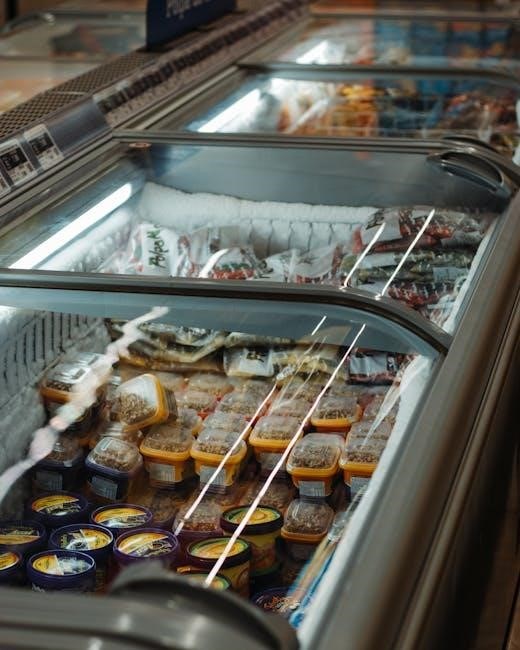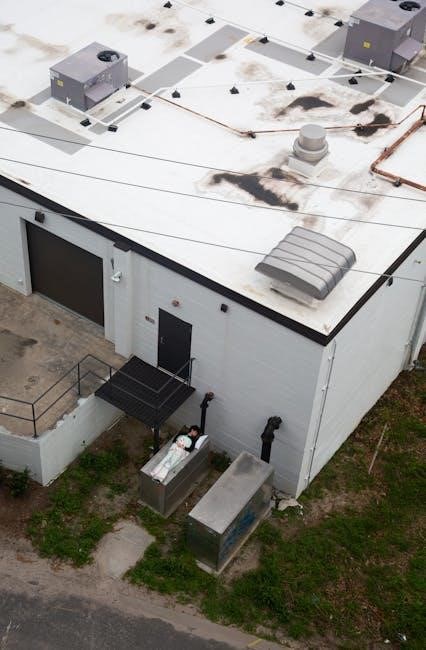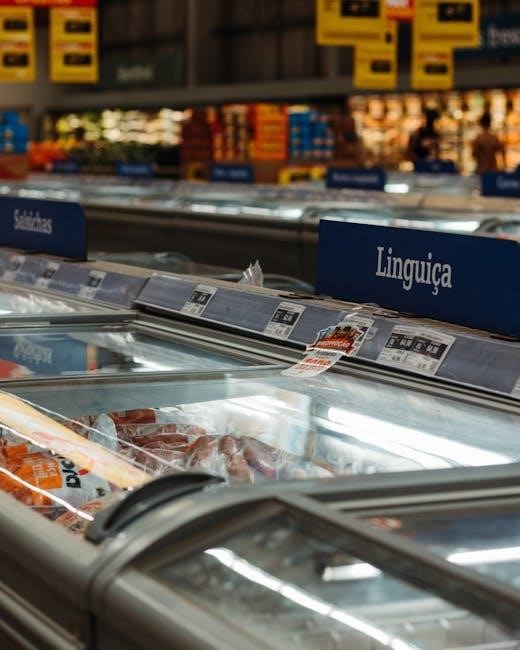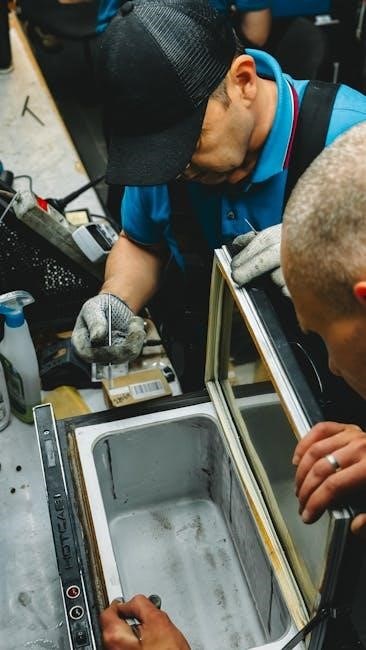
Refrigeration and air conditioning technology are essential for maintaining thermal comfort and preserving perishable goods. These systems utilize principles of heat transfer and thermodynamics to regulate temperatures efficiently‚ ensuring energy savings and environmental sustainability.
Definition and Overview
Refrigeration and air conditioning technology involves the control of temperature and humidity to maintain desired environmental conditions. It encompasses systems that transfer heat from one location to another‚ enabling cooling for various applications. Key components include compressors‚ condensers‚ and evaporators‚ which work together in refrigeration cycles. These technologies are fundamental in preserving food‚ cooling spaces‚ and enabling industrial processes. Modern systems integrate advanced thermodynamic principles‚ energy-efficient designs‚ and eco-friendly refrigerants. The field continues to evolve‚ addressing challenges like ozone depletion and energy consumption while advancing innovations in heating‚ ventilation‚ and air conditioning (HVAC) systems.
Importance in Modern Society
Refrigeration and air conditioning technologies are vital in modern society‚ enabling food preservation‚ medical storage‚ and climate control. They prevent spoilage‚ ensure vaccine efficacy‚ and support industrial manufacturing. These systems enhance comfort‚ productivity‚ and health‚ making them indispensable in homes‚ hospitals‚ and industries. Their role in global food security and economic stability underscores their significance‚ driving advancements to meet growing demands sustainably.
Basic Components
Refrigeration and air conditioning systems consist of key components: a compressor‚ condenser‚ expansion valve‚ and evaporator. The compressor pressurizes refrigerant‚ while the condenser dissipates heat. The expansion valve reduces pressure‚ allowing refrigerant to expand‚ and the evaporator absorbs heat from the surrounding environment. These components work together to facilitate heat transfer and maintain desired temperatures. Electrical circuits and controls regulate system operation‚ ensuring efficiency and safety. Proper functioning of these elements is crucial for effective cooling and climate control in various applications.

Historical Development
Refrigeration and air conditioning technology evolved from early ice harvesting to mechanical systems in the 1800s. Innovations like vapor-compression systems and safer refrigerants marked significant milestones‚ shaping modern cooling solutions.
Early Innovations
The transition from natural ice harvesting to mechanical refrigeration in the 19th century revolutionized cooling technology; Oliver Evans proposed the first vapor-compression system in 1805‚ while Jacob Perkins built the first practical model in 1834. These early innovations laid the groundwork for modern systems. By the mid-1800s‚ refrigeration became vital for food preservation and industrial processes. The development of ammonia-based systems further advanced the field‚ enabling widespread use in commercial and residential applications. These pioneering efforts marked the beginning of a technological evolution that would transform industries and daily life‚ setting the stage for the sophisticated systems we rely on today.
Evolution of Technology
Refrigeration and air conditioning technology has advanced significantly‚ transitioning from basic mechanical systems to sophisticated‚ energy-efficient solutions. Modern innovations include inverter technology‚ enabling variable-speed operation for enhanced performance. Smart systems integrate IoT capabilities‚ optimizing temperature control and energy use. The development of magnetic refrigeration and alternative refrigerants like HFCs addresses environmental concerns. These advancements ensure reduced energy consumption and lower environmental impact‚ aligning with global sustainability goals. Continuous innovation drives the industry forward‚ offering cutting-edge solutions for diverse applications‚ from residential comfort to industrial processes‚ ensuring reliable and efficient temperature management in an ever-evolving world.

Fundamental Principles
Refrigeration and air conditioning rely on the refrigeration cycle‚ thermodynamic principles‚ and heat transfer mechanisms to regulate temperatures efficiently‚ ensuring energy conservation and optimal performance in various applications.
Refrigeration Cycle
The refrigeration cycle is a thermodynamic process that transfers heat from a cooler to a hotter location. It involves four key stages: evaporation‚ compression‚ condensation‚ and expansion. In evaporation‚ the refrigerant absorbs heat from the surrounding environment. Compression raises the refrigerant’s temperature and pressure‚ enabling heat release during condensation. Expansion reduces pressure‚ preparing the refrigerant for reuse. This cycle is essential for cooling systems‚ ensuring efficient heat removal and energy conservation. Proper understanding of the refrigeration cycle is critical for optimizing system performance‚ reducing energy consumption‚ and minimizing environmental impact in various applications.
Thermodynamic Basics
Thermodynamic principles form the foundation of refrigeration and air conditioning systems. The first law of thermodynamics‚ energy conservation‚ governs heat and work interactions. The second law introduces entropy‚ a measure of disorder‚ influencing heat transfer direction and system efficiency. Psychrometrics‚ the study of air-water mixtures‚ is crucial for air conditioning‚ addressing humidity and enthalpy. Understanding these principles enables the design of efficient cooling systems‚ optimizing performance and energy use. They are applied in calculating heat loads‚ selecting equipment‚ and ensuring system reliability across various applications‚ from residential cooling to industrial refrigeration‚ making thermodynamics indispensable in this field.
Heat Transfer Mechanisms
Heat transfer mechanisms are fundamental to refrigeration and air conditioning systems. Conduction‚ convection‚ and radiation are the primary modes of heat transfer. Conduction occurs through direct contact between materials‚ while convection involves fluid motion transferring heat. Radiation transmits energy via electromagnetic waves. These mechanisms are critical in designing efficient heat exchangers‚ such as condensers and evaporators. Factors like surface area‚ material properties‚ and fluid flow rates significantly influence heat transfer efficiency. Understanding these principles is essential for optimizing system performance‚ reducing energy consumption‚ and ensuring reliable operation in various applications‚ from residential cooling to industrial refrigeration.

Types of Refrigeration Systems
Refrigeration systems include vapor-compression‚ absorption‚ and ammonia-based technologies. Each operates on distinct principles‚ offering tailored solutions for commercial‚ industrial‚ and residential applications.
Vapor-Compression Systems
Vapor-compression systems are widely used in refrigeration and air conditioning‚ operating on a continuous cycle of compression‚ condensation‚ expansion‚ and evaporation. The compressor raises refrigerant vapor pressure and temperature‚ which is then cooled and condensed in the condenser. The expansion valve reduces pressure‚ allowing the refrigerant to expand and become a low-pressure liquid or mist. Finally‚ the evaporator absorbs heat from the surrounding environment‚ cooling the space. These systems are efficient and reliable‚ commonly used in residential and commercial applications. Modern advancements focus on improving energy efficiency and reducing environmental impact through eco-friendly refrigerants and optimized designs.
Absorption Systems
Absorption systems use heat energy to drive the refrigeration process‚ making them highly efficient and environmentally friendly. These systems typically use water and ammonia or water and lithium bromide as the working fluids. The process involves absorption‚ where the refrigerant is absorbed by a solution‚ followed by heating to separate the refrigerant. These systems are ideal for applications with waste heat sources‚ such as industrial plants or solar energy systems. Absorption systems are known for their low electrical energy consumption and reduced greenhouse gas emissions‚ making them a sustainable option for heating‚ cooling‚ and refrigeration needs in various industries.
Ammonia Systems
Ammonia systems are highly efficient and widely used in industrial refrigeration due to their superior thermodynamic properties. As a natural refrigerant‚ ammonia has zero ozone depletion and global warming potential‚ making it an environmentally friendly choice. These systems are commonly employed in large-scale applications‚ such as food processing and cold storage facilities. However‚ ammonia’s toxicity requires specialized safety measures and venting systems. Despite these challenges‚ ammonia remains a preferred option for high-capacity refrigeration needs‚ offering significant energy savings and reliability in demanding operational environments compared to traditional synthetic refrigerants.

Applications
Refrigeration and air conditioning are vital in preserving food‚ controlling industrial processes‚ and maintaining comfort in residential and commercial spaces‚ ensuring safety and efficiency across various sectors.
Commercial Use
Refrigeration and air conditioning systems are indispensable in commercial settings‚ ensuring food safety and maintaining optimal storage conditions. Supermarkets rely on these technologies to preserve perishables‚ while restaurants use them for food preparation and customer comfort. Additionally‚ commercial HVAC systems regulate humidity and temperature in retail spaces‚ enhancing product quality and customer satisfaction. Energy-efficient designs are increasingly adopted to reduce operational costs and environmental impact‚ making these technologies critical for modern commerce. Their widespread application underscores their importance in supporting industry operations and sustainability goals.
Industrial Use
Industrial applications of refrigeration and air conditioning technology are vital for maintaining precise temperature controls in manufacturing processes. These systems prevent overheating in machinery‚ ensuring operational efficiency and longevity. In sectors like pharmaceuticals‚ consistent cooling is crucial for producing and storing temperature-sensitive products. Additionally‚ industrial cooling systems support large-scale food processing‚ preventing spoilage and ensuring safety. Advanced technologies‚ such as magnetic refrigeration‚ are being integrated to enhance performance and reduce environmental impact. These systems play a pivotal role in sustaining industrial productivity and meeting stringent quality standards across various sectors.
Residential Use
Refrigeration and air conditioning technology are indispensable in residential settings‚ providing thermal comfort and preserving food. Home systems‚ such as refrigerators and split-type air conditioners‚ operate efficiently to maintain desired temperatures. These systems incorporate advanced electrical circuits and energy-saving features‚ minimizing energy consumption. Modern designs emphasize quiet operation and compact sizing to suit urban living spaces. Proper installation and maintenance ensure optimal performance‚ extending equipment lifespan. Residential applications highlight the importance of balancing comfort with energy efficiency‚ making these technologies a cornerstone of modern households worldwide.

Environmental Impact
Ozone depletion and greenhouse gas emissions from refrigerants pose significant environmental challenges. Developing eco-friendly alternatives and improving energy efficiency are critical for sustainability.
Ozone Depletion
The ozone layer is severely impacted by refrigerants like HCFCs‚ which release chlorine atoms‚ causing depletion. The Montreal Protocol phased out ozone-depleting substances‚ promoting alternatives like HFCs. However‚ HFCs contribute to global warming‚ driving research for eco-friendly refrigerants. Transitioning to natural refrigerants and improving system efficiency are critical to minimizing environmental harm. Proper disposal and recycling of refrigerants further reduce ozone-depleting emissions. Regulatory compliance and sustainable practices are essential to protect the ozone layer and mitigate climate change impacts from refrigeration systems.
Refrigerant Alternatives
Refrigerant alternatives are critical to reducing environmental impact. Hydrofluoroolefins (HFOs) and natural refrigerants like CO2 and ammonia are gaining traction as eco-friendly options. HFOs offer low global warming potential‚ while natural refrigerants are ozone-friendly but require safety measures due to toxicity or flammability. Regulations and industry initiatives drive the adoption of these alternatives‚ ensuring compliance with environmental standards. Research continues to refine these technologies‚ balancing performance‚ safety‚ and sustainability. Transitioning to alternative refrigerants is vital for mitigating climate change and meeting global emissions targets while maintaining efficient cooling systems across industries.
Energy Efficiency
Energy efficiency in refrigeration and air conditioning systems is crucial for reducing operational costs and environmental impact. Modern technologies like inverter-driven compressors and smart sensors optimize energy use by adjusting performance based on demand. High-efficiency units with improved heat exchangers and better insulation minimize energy losses. Additionally‚ smart systems integrate with building management software to monitor and control energy consumption. Governments and organizations promote energy-efficient standards‚ encouraging the adoption of greener technologies. These advancements ensure sustainable cooling solutions while maintaining performance‚ making them indispensable in today’s eco-conscious world.

Modern Advances
Modern refrigeration and air conditioning technology leverages inverter technology‚ magnetic refrigeration‚ and smart systems for enhanced efficiency and performance‚ reducing energy consumption and environmental impact significantly.
Inverter Technology
Inverter technology in refrigeration and air conditioning systems enables variable-speed operation of compressors and fans‚ optimizing performance based on demand. This reduces energy consumption significantly while maintaining precise temperature control. By adjusting cooling and heating output dynamically‚ inverters minimize operational noise and vibrations‚ enhancing efficiency and reliability. They also integrate seamlessly with smart systems‚ allowing for remote monitoring and adaptive operation. This advancement not only improves energy efficiency but also reduces environmental impact by lowering greenhouse gas emissions. Inverter-driven systems are increasingly popular in modern applications‚ offering a balance of cost-effectiveness and high performance.
Smart Systems
Smart systems in refrigeration and air conditioning integrate IoT (Internet of Things) technology for enhanced efficiency and control. These systems use sensors and AI algorithms to monitor and adjust temperature‚ humidity‚ and airflow in real-time‚ ensuring optimal comfort and energy savings. Remote access via smartphones or tablets allows users to manage settings dynamically. Smart systems also enable predictive maintenance‚ detecting potential issues before they occur‚ thus reducing downtime and extending equipment lifespan. Additionally‚ they can learn user preferences over time‚ adapting operations to individual needs. This intelligent approach not only improves performance but also contributes to a more sustainable and connected future.
Magnetic Refrigeration
Magnetic refrigeration is an innovative cooling technology that uses magnetic fields to transfer heat‚ eliminating the need for traditional refrigerants. This eco-friendly approach reduces reliance on ozone-depleting substances like HCFCs and HFCs. By leveraging the magnetocaloric effect‚ materials change temperature when exposed to magnetic fields‚ enabling efficient cooling. Astronautics Corp of America is pioneering this technology with a $2.9 million grant‚ aiming to develop next-generation systems. Magnetic refrigeration offers potential for higher energy efficiency‚ lower environmental impact‚ and quieter operation‚ making it a promising alternative for future air conditioning and refrigeration applications.

Maintenance and Troubleshooting
Regular servicing of electrical circuits and components ensures efficient operation‚ extends equipment lifespan‚ and prevents breakdowns in refrigeration and air conditioning systems.
Best Practices
Regular maintenance is crucial for optimal performance of refrigeration and air conditioning systems. This includes inspecting refrigerant levels‚ cleaning condenser and evaporator coils‚ and checking electrical connections. Ensuring proper airflow and sealing leaks can improve efficiency and prevent energy waste. Adhering to safety protocols and manufacturer guidelines is essential for troubleshooting and servicing. Routine checks on compressors‚ fans‚ and thermostats help identify issues early‚ reducing downtime and extending equipment lifespan. Proper documentation and record-keeping of maintenance activities ensure accountability and compliance with environmental standards. These practices contribute to energy efficiency‚ reliability‚ and sustainability in HVAC systems.
Electrical Circuits
Understanding electrical circuits is vital for diagnosing and servicing refrigeration and air conditioning systems. These systems rely on complex electrical circuits‚ including power supply‚ control‚ and safety circuits. Domestic refrigeration systems use basic electric circuits‚ while advanced systems incorporate components like contactors‚ capacitors‚ and relays. Proper wiring and circuit design ensure efficient operation and safety. Technicians must analyze circuit diagrams to identify faults‚ such as short circuits or open connections. Regular inspection of electrical components‚ like fuses and circuit breakers‚ prevents system failures. Knowledge of electrical circuits is essential for troubleshooting and maintaining energy efficiency in HVAC systems.
Servicing Techniques
Servicing refrigeration and air conditioning systems requires precise techniques to ensure optimal performance. Routine inspections involve checking refrigerant levels‚ filters‚ and electrical connections. Technicians use diagnostic tools to identify issues like leaks or compressor inefficiencies. Cleaning condenser coils and evaporators improves heat transfer efficiency. Recharging refrigerants and replacing worn parts are common tasks. Electrical system checks ensure safe and efficient operation. Proper servicing extends equipment lifespan‚ reduces energy consumption‚ and prevents breakdowns. Adhering to safety protocols and manufacturer guidelines is crucial for effective servicing. Regular maintenance ensures systems operate reliably‚ maintaining desired temperatures and humidity levels in various applications. Proper techniques are essential for sustainable operation.

Future Trends
Future trends in refrigeration and air conditioning include magnetic refrigeration‚ inverter technology‚ and smart systems. These innovations enhance efficiency‚ reduce emissions‚ and integrate with IoT for better control.
Alternative Refrigerants
Alternative refrigerants are being developed to address environmental concerns‚ particularly ozone depletion and global warming. Hydrofluoroolefins (HFOs) and natural refrigerants like CO2 and ammonia are gaining popularity. These alternatives offer lower global warming potential (GWP) compared to traditional hydrofluorocarbons (HFCs) and hydrochlorofluorocarbons (HCFCs). HFOs blend well with existing systems‚ while CO2 systems‚ known as R-744‚ are efficient in industrial applications. Ammonia‚ though toxic‚ is highly efficient and used in large-scale refrigeration. The transition to these refrigerants requires updates in system design‚ safety protocols‚ and technician training to ensure safe and effective implementation;
IoT Integration
IoT integration in refrigeration and air conditioning systems enhances efficiency and monitoring. Smart sensors and connected devices enable real-time data collection and analysis‚ optimizing performance and energy use. Automated controls adjust temperatures and humidity based on demand‚ reducing waste. Remote monitoring allows technicians to troubleshoot issues preemptively‚ minimizing downtime. Advanced analytics predict maintenance needs and system failures‚ ensuring proactive management. IoT-enabled systems also integrate with building management software‚ offering centralized control and energy-saving opportunities. This technology improves reliability‚ reduces operational costs‚ and supports sustainability goals‚ making it a cornerstone of modern HVAC/R advancements.

Education and Training
Education and training in refrigeration and air conditioning involve comprehensive resources like textbooks and online courses‚ covering theory and practical aspects. Practical training enhances skill development.
Textbooks and Resources
Textbooks like “Refrigeration and Air Conditioning Technology” by John Tomczyk‚ Bill Whitman‚ and Bill Johnson provide comprehensive coverage of HVAC/R systems. These resources include detailed explanations of heat transfer‚ electrical circuits‚ and thermodynamic principles. Practical training materials‚ such as those from MIT‚ focus on real-world applications‚ including domestic appliances and industrial systems. Online resources and PDF guides offer accessible learning tools‚ ensuring technicians gain both theoretical and hands-on knowledge to excel in the field. These textbooks are essential for understanding the fundamentals and staying updated with modern advancements in refrigeration and air conditioning technology.
Online Courses
Online courses offer flexible learning opportunities for refrigeration and air conditioning technology. Platforms provide comprehensive modules on thermodynamic principles‚ refrigeration cycles‚ and system design. Practical training simulations and interactive exercises enhance understanding. Courses cover electrical circuits‚ system maintenance‚ and energy efficiency.Certifications are often available‚ ensuring technicians meet industry standards. These resources are ideal for both beginners and professionals seeking to update their skills. With accessible learning tools‚ online courses bridge the gap between theory and practice‚ preparing individuals for real-world challenges in HVAC/R systems. They are a vital part of modern education in this rapidly evolving field.
Practical Training
Practical training is crucial for mastering refrigeration and air conditioning technology. Hands-on experience with tools and diagnostic equipment prepares technicians to service and troubleshoot systems effectively. Training programs often include disassembling and reassembling components‚ such as compressors and condensers. Students learn to identify and repair leaks‚ test electrical circuits‚ and optimize system performance. Real-world simulations help develop problem-solving skills. Practical training also covers safety protocols and environmental regulations‚ ensuring compliance with industry standards. By combining theoretical knowledge with practical application‚ technicians gain the expertise needed to maintain and improve HVAC/R systems efficiently. This approach ensures they are well-prepared for real-world challenges.
Refrigeration and air conditioning technology are vital for modern life‚ ensuring comfort and preservation. Advances in efficiency and sustainability highlight the industry’s commitment to eco-friendly solutions‚ shaping a greener future.
Industry Outlook
The refrigeration and air conditioning industry is poised for growth‚ driven by increasing demand for energy-efficient solutions and advancements in technology. As urbanization rises‚ so does the need for climate control systems. Environmental regulations are pushing the adoption of eco-friendly refrigerants and sustainable practices. Emerging technologies like magnetic refrigeration and smart systems are reshaping the market. The industry is also expected to integrate more with renewable energy sources‚ reducing carbon footprints. With a focus on innovation and sustainability‚ the future of HVAC/R systems looks promising‚ offering both opportunities and challenges for manufacturers and technicians alike.
Importance of Staying Updated
Staying updated in refrigeration and air conditioning technology is crucial for adapting to evolving industry standards‚ environmental regulations‚ and technological advancements. New refrigerants‚ energy-efficient systems‚ and smart technologies require continuous learning to remain competitive. Updated knowledge ensures compliance with safety and environmental laws‚ enhancing system performance and reliability. Technicians and professionals must engage with the latest resources‚ such as textbooks and online courses‚ to stay informed about best practices and innovative solutions. This commitment to lifelong learning fosters innovation and sustainability in the HVAC/R field‚ addressing global challenges while meeting growing demands for climate control and energy efficiency.